An article discussing how to use a multimeter in diagnosis of electrical problems in a Jeep vehicle.
A multimeter is a great tool that everyone should take the time and learn how to use properly. A multimeter can tell you if the battery is good, the alternator is charging, or if there is a break in a wire. It can test a connection, and can test vehicle sensors (TPS / MAP / Crank / etc), along with many other things.
Any multimeter can help you perform basic tests and get simple answers. Units can range from $20 into the $100's. However much you'd prefer to spend on one would be completely up to you, but any one of them would work.
The first standard test is to check your car battery's voltage. With the multimeter set on DCV, Direct Current Voltage, this can be easily tested. Touch the positive wire lead to the positive terminal of the battery, and repeat with the negative side. This reading is your current battery's voltage life. The reading should be around 12.6V with the vehicle and all accessories off. If it is lower, the battery might need to be replaced.
A standard battery voltage rate compared to charge percentage would be follows:
Cracking the engine over will show the total draw of the starting system, your battery should not drop below 10.8 volts while cracking. After the vehicle has started, if the voltage is showing at 13.8V to 15V, then you'll know that the alternator is operating correctly.
To check for voltage going to a certain fused system, simply ground the multimeter with the black lead to any good ground contact. With the multimeter set on DCV, touch any fuse system to check current power draw. This can be done with the fuse still in place, as a small section on the back of the fuse itself is open to allow this type of test.
The next feature of your multimeter, and the main part of how to test sensors, is the OHMs setting. This is used to measure resistance of circuits. Giving you the ability to measure sensors to check if they are in range, or to check circuits for breaks. Also, this will allow the user to determine any sort of voltage drop over a specific circuit.
The multimeter will have multiple settings for testing resistance. Start with the smallest rated setting, unless you know the range you need to test, and go from there. Most of the time the 100-200 range will work for everything. When measuring the specifics you have chosen, the red and black leads do not have a set side. The meter is only measuring continuity between the points.
The best use of this meter setting is to test vehicle sensors. Fuel sending unit, Throttle Position sensor, Oxygen Sensor, and many more are all examples of easily testable sensors. The only thing needed would be manufacturer information on the resistance ratings of each individual sensor. Just because it shows a reading doesn't necessarily mean it's within spec.
Anyone who works on Jeeps should own a meter, and know how to use it. A meter can tell you if your battery is good, alternator is charging, if there is a break in a wire, if something is a good connection, test sensors like TPS/MAP/Crank/etc., and many other things. This is only meant to be a very basic outline, there will be no technical terms or theories, just how to use the meter.
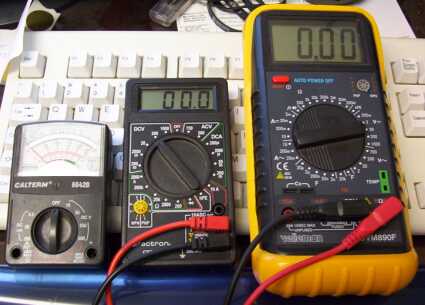 There are three examples of meters here, the one on the left cost $10, the one in the middle cost around $20, and the one on the right cost around $35. The one in the middle, it’s a basic digital multi-meter, is generally the best to get. The cheap one will get you by, but it’s harder to tell exact voltages on that analog display.
There are three examples of meters here, the one on the left cost $10, the one in the middle cost around $20, and the one on the right cost around $35. The one in the middle, it’s a basic digital multi-meter, is generally the best to get. The cheap one will get you by, but it’s harder to tell exact voltages on that analog display.
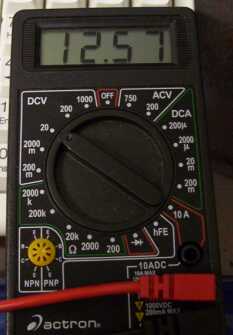 First thing is to check voltage. Jeeps run off a DC system, and are generally 12 volts, therefore switch the meter to DCV (DC Volts) 20 (no more than 20 volts).
First thing is to check voltage. Jeeps run off a DC system, and are generally 12 volts, therefore switch the meter to DCV (DC Volts) 20 (no more than 20 volts).
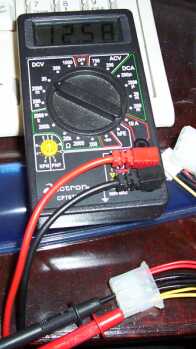 Black to negative, Red to positive. We don't have any picture of this on a Jeep battery, so a PC power supply as an example. Touch the black to the ground, red to the positive, and the battery shows 12.57 volts.
Black to negative, Red to positive. We don't have any picture of this on a Jeep battery, so a PC power supply as an example. Touch the black to the ground, red to the positive, and the battery shows 12.57 volts.
With the Jeep off a battery should show roughly 12.5 volts. When cranking the motor, the battery should hold a voltage of at least 10.5, nothing less. If it is less your battery is run down, dead, bad, or it may be a bad starter. When running your alternator should put out between 14-15 volts, generally shouldn't be less or more.
Want to check for voltage say to a fuse inside the Jeep. Touch the black lead to anything metal, a seat bolt for example, for a ground. Touch the red lead to the fuse socket, (try both sides, only one side of a fuse socket is live without the fuse), should come up with 12 volts if it’s live.
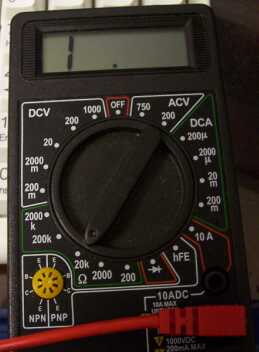 The next important thing to understand is resistance. Measuring resistance with a meter can quickly tell you if a wire has a break in it, or if something is a good connection, etc. Again I'm going to try and keep this as easy as possible. When measuring resistance red and black doesn't matter, all the meter does is check for continuity.
The next important thing to understand is resistance. Measuring resistance with a meter can quickly tell you if a wire has a break in it, or if something is a good connection, etc. Again I'm going to try and keep this as easy as possible. When measuring resistance red and black doesn't matter, all the meter does is check for continuity.
The symbol for Ohms is under the 20k there on the bottom. You can see I have selected 20k ohms for my tests, this will generally be fine for most tasks. Right now the meter is display 1___.___, this means infinity on this meter, or there is no continuity (the leads are not connected or touching in any way).
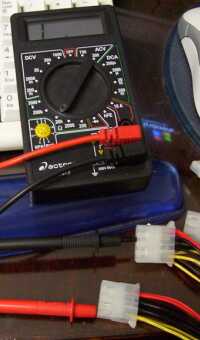 In this picture below, the meter is essentially checking to see if the yellow wire and the black wire meet at some point. The meter reads infinity, or no continuity, so we know the yellow and black wires do not meet or touch at any point.
In this picture below, the meter is essentially checking to see if the yellow wire and the black wire meet at some point. The meter reads infinity, or no continuity, so we know the yellow and black wires do not meet or touch at any point.
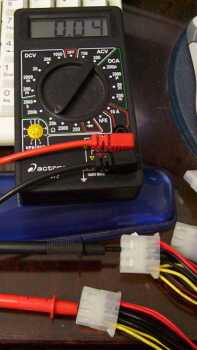 In this picture, the leads touching a black wire on each clip. The meter is reading 0.04, or very little resistance, meaning these wires do have continuity and are connected. All wires will have a little resistance, or loss, so the 0.04 reading is normal, some wires will have a little more, some will have a little less.
In this picture, the leads touching a black wire on each clip. The meter is reading 0.04, or very little resistance, meaning these wires do have continuity and are connected. All wires will have a little resistance, or loss, so the 0.04 reading is normal, some wires will have a little more, some will have a little less.
Next, say we want to check for a ground? Attach one lead on a known good ground, the black wire. Now to tell if the power supply casing is grounded, just touch the other lead (remember color doesn't matter) to the casing. Meter reads 0.05, very little resistance so the casing is grounded.
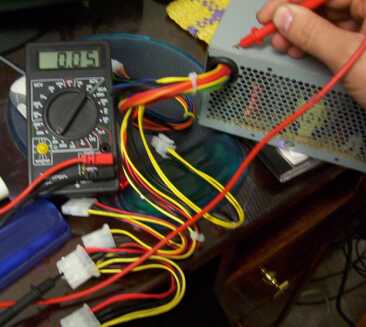
Don't get to hung up on the meter readings when measuring resistance, its pretty much infinity (1___.___ on this meter), or something close to 0 when there is continuity.
Ok so now why do you need to understand resistance? Many sensors on Jeeps today work off changes in resistance. For example a TPS sensor generally works off resistance, as the pedal travels the sensor changes resistance. Many times when TPS sensors go bad, they can develop bad spots, checking resistance on the TPS, and cycling it through its motion will reveal any bad spots, as the resistance will jump at the bad spot. Other things do this too, some Crankshaft Position Sensors work off resistance, when the magnet gets close to something metal the leads will have continuity, when its not there won't be continuity.
Courtesy of OhioYJ Quadratec BB
Any multimeter can help you perform basic tests and get simple answers. Units can range from $20 into the $100's. However much you'd prefer to spend on one would be completely up to you, but any one of them would work.
The first standard test is to check your car battery's voltage. With the multimeter set on DCV, Direct Current Voltage, this can be easily tested. Touch the positive wire lead to the positive terminal of the battery, and repeat with the negative side. This reading is your current battery's voltage life. The reading should be around 12.6V with the vehicle and all accessories off. If it is lower, the battery might need to be replaced.
A standard battery voltage rate compared to charge percentage would be follows:
- 12.60 volts = 100% charge
- 12.35 volts = 75% charge
- 12.10 volts = 50% charge
- 11.95 volts = 25% charge
- 11.70 volts (or less) = 0% charge
Cracking the engine over will show the total draw of the starting system, your battery should not drop below 10.8 volts while cracking. After the vehicle has started, if the voltage is showing at 13.8V to 15V, then you'll know that the alternator is operating correctly.
To check for voltage going to a certain fused system, simply ground the multimeter with the black lead to any good ground contact. With the multimeter set on DCV, touch any fuse system to check current power draw. This can be done with the fuse still in place, as a small section on the back of the fuse itself is open to allow this type of test.
The next feature of your multimeter, and the main part of how to test sensors, is the OHMs setting. This is used to measure resistance of circuits. Giving you the ability to measure sensors to check if they are in range, or to check circuits for breaks. Also, this will allow the user to determine any sort of voltage drop over a specific circuit.
The multimeter will have multiple settings for testing resistance. Start with the smallest rated setting, unless you know the range you need to test, and go from there. Most of the time the 100-200 range will work for everything. When measuring the specifics you have chosen, the red and black leads do not have a set side. The meter is only measuring continuity between the points.
The best use of this meter setting is to test vehicle sensors. Fuel sending unit, Throttle Position sensor, Oxygen Sensor, and many more are all examples of easily testable sensors. The only thing needed would be manufacturer information on the resistance ratings of each individual sensor. Just because it shows a reading doesn't necessarily mean it's within spec.
Anyone who works on Jeeps should own a meter, and know how to use it. A meter can tell you if your battery is good, alternator is charging, if there is a break in a wire, if something is a good connection, test sensors like TPS/MAP/Crank/etc., and many other things. This is only meant to be a very basic outline, there will be no technical terms or theories, just how to use the meter.
 There are three examples of meters here, the one on the left cost $10, the one in the middle cost around $20, and the one on the right cost around $35. The one in the middle, it’s a basic digital multi-meter, is generally the best to get. The cheap one will get you by, but it’s harder to tell exact voltages on that analog display.
There are three examples of meters here, the one on the left cost $10, the one in the middle cost around $20, and the one on the right cost around $35. The one in the middle, it’s a basic digital multi-meter, is generally the best to get. The cheap one will get you by, but it’s harder to tell exact voltages on that analog display.  First thing is to check voltage. Jeeps run off a DC system, and are generally 12 volts, therefore switch the meter to DCV (DC Volts) 20 (no more than 20 volts).
First thing is to check voltage. Jeeps run off a DC system, and are generally 12 volts, therefore switch the meter to DCV (DC Volts) 20 (no more than 20 volts).  Black to negative, Red to positive. We don't have any picture of this on a Jeep battery, so a PC power supply as an example. Touch the black to the ground, red to the positive, and the battery shows 12.57 volts.
Black to negative, Red to positive. We don't have any picture of this on a Jeep battery, so a PC power supply as an example. Touch the black to the ground, red to the positive, and the battery shows 12.57 volts.With the Jeep off a battery should show roughly 12.5 volts. When cranking the motor, the battery should hold a voltage of at least 10.5, nothing less. If it is less your battery is run down, dead, bad, or it may be a bad starter. When running your alternator should put out between 14-15 volts, generally shouldn't be less or more.
Want to check for voltage say to a fuse inside the Jeep. Touch the black lead to anything metal, a seat bolt for example, for a ground. Touch the red lead to the fuse socket, (try both sides, only one side of a fuse socket is live without the fuse), should come up with 12 volts if it’s live.
 The next important thing to understand is resistance. Measuring resistance with a meter can quickly tell you if a wire has a break in it, or if something is a good connection, etc. Again I'm going to try and keep this as easy as possible. When measuring resistance red and black doesn't matter, all the meter does is check for continuity.
The next important thing to understand is resistance. Measuring resistance with a meter can quickly tell you if a wire has a break in it, or if something is a good connection, etc. Again I'm going to try and keep this as easy as possible. When measuring resistance red and black doesn't matter, all the meter does is check for continuity.The symbol for Ohms is under the 20k there on the bottom. You can see I have selected 20k ohms for my tests, this will generally be fine for most tasks. Right now the meter is display 1___.___, this means infinity on this meter, or there is no continuity (the leads are not connected or touching in any way).
 In this picture below, the meter is essentially checking to see if the yellow wire and the black wire meet at some point. The meter reads infinity, or no continuity, so we know the yellow and black wires do not meet or touch at any point.
In this picture below, the meter is essentially checking to see if the yellow wire and the black wire meet at some point. The meter reads infinity, or no continuity, so we know the yellow and black wires do not meet or touch at any point. In this picture, the leads touching a black wire on each clip. The meter is reading 0.04, or very little resistance, meaning these wires do have continuity and are connected. All wires will have a little resistance, or loss, so the 0.04 reading is normal, some wires will have a little more, some will have a little less.
In this picture, the leads touching a black wire on each clip. The meter is reading 0.04, or very little resistance, meaning these wires do have continuity and are connected. All wires will have a little resistance, or loss, so the 0.04 reading is normal, some wires will have a little more, some will have a little less.Next, say we want to check for a ground? Attach one lead on a known good ground, the black wire. Now to tell if the power supply casing is grounded, just touch the other lead (remember color doesn't matter) to the casing. Meter reads 0.05, very little resistance so the casing is grounded.

Don't get to hung up on the meter readings when measuring resistance, its pretty much infinity (1___.___ on this meter), or something close to 0 when there is continuity.
Ok so now why do you need to understand resistance? Many sensors on Jeeps today work off changes in resistance. For example a TPS sensor generally works off resistance, as the pedal travels the sensor changes resistance. Many times when TPS sensors go bad, they can develop bad spots, checking resistance on the TPS, and cycling it through its motion will reveal any bad spots, as the resistance will jump at the bad spot. Other things do this too, some Crankshaft Position Sensors work off resistance, when the magnet gets close to something metal the leads will have continuity, when its not there won't be continuity.
Courtesy of OhioYJ Quadratec BB
Article Type:
How It Works
Category:
Electrical Tech











